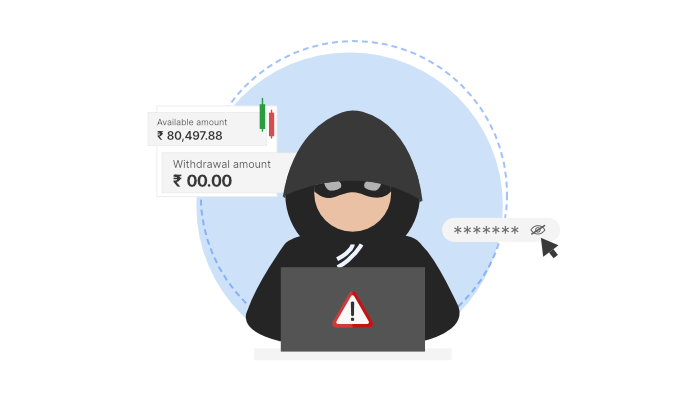
The nuisance of fake trading apps
Many people, influenced by social media, friends, or relatives, believe that making money in the stock market is easy. This leads individuals to start trading and investing with unrealistic expectations. However, as Nithin says, “Stock markets are the toughest place in the world to make easy money in the long run”.
These unrealistic expectations also make people vulnerable to financial scams. There are numerous such scams, including phishing scams, fraudulent advisory services, scams targeting the elderly, and the classic pump-and-dump schemes.
At Zerodha, we have taken several steps to help prevent these scams. These measures include blocking illiquid option contracts, reporting any suspicious trades to the exchanges, alerting customers via Nudge when a stock is flagged as a risky penny stock during the buy order process, and raising awareness about these scams on social media.
However, we have recently encountered a new type of sophisticated scam: fake trading apps. These scams have become a significant problem, with thousands of people losing crores of their hard-earned money. To help raise awareness, we explain how these scams operate, why people are drawn into them, and how you can protect yourself from falling victim.
Check out this video on fake trading apps.
How do fake trading apps operate?
Fake trading apps are designed to take advantage of people’s trust. Victims often see small, convincing returns at first, which builds trust and encourages them to invest more money. These scams operate in an extremely effective manner. Here’s how it usually goes:
1. Initial contact
You receive a message on WhatsApp from a random person promising lucrative weekly profits in the stock market. The sender provides free trading study materials and invites you to join a WhatsApp group full of seemingly successful traders.

2. App download
The group admin convinces you to download an app that looks and feels legitimate. You are sceptical at first, but a polished app store page and fabricated positive reviews persuade you.
3. Initial investment
You are then asked to invest a minimum amount—say, ₹50,000. The admin walks you through the process, even providing his bank account details. You make the transfer, and the money shows up in your app.”
4. Fake success
After following the admin’s stock tips, you see a substantial increase in your investments—on paper, at least. This encourages you to invest even more, convinced that you can gain even bigger profits.
5. The scam revealed
When you attempt to withdraw your money, you’re asked to pay various fees—capital gains tax, platform fees, and even a commission to the “advisor.” After you’ve paid all these fees, you find that you still can’t withdraw your funds. The admin blocks you, and you realise that all your investments were fake.
How can you save yourself from such scams?
To ensure you do not fall victim to such scams, ensure the following:
- Only download from trusted sources: Never download an app from outside official stores like Google Play or the Apple App Store. Even if the app is in the store, double-check the developer’s information.
- Verify brokers: Make sure your broker is registered with SEBI. You can verify this on SEBI’s official website here.
- Be sceptical of too-good-to-be-true offers: If someone guarantees high returns with minimal risk, it’s likely a scam.
- Never transfer money to personal accounts. Always use the official app or website of a registered broker to transfer funds.
- Report suspicious activity: If you suspect a scam, report it to the National Cyber Crime Reporting Portal or call their helpline at 1930.

Dear Cyber Crime Officers,
Please take drastic actions on (B2) Zerodha Value Added Program and also on other scammers in India and out side nation and send relief on online fraud victims and severe punishments on very very wrong and non social people
Lots of thanks in advance
Regards to entire Team Cyber Crime Officers
I also lost same way. I really appreciate your work sir. But the main thing is how perticular zerodha customer\’s number the scammer got. How they approach us with our zerodha account details thinks about it sir. Why other brokers customer not complaining about scam.
This information is even less than what is provided by the scammers and seems less convening. Scammers have masters these in a better ways and even after checking these people are falling prey to the scammers.
If the scam in running in your name it is harming your image also. It is your duty and responsibility to get these scammer arrested and get their money back because they are investing on your trust.
Think if
Tommorow out of fear if all your investors leave you what will happen to your company.
Think if the investors loose trust in you and you don\’t have any investors with you what will. Happen.
If the investors loose all their money to scammers
and they don\’t have any money to invest what will happen.
There can be may more scenarios imagin them and act for the safety of your investors.
Because of the investors are there you will be there.
Hope you understand.
If you have understood. Please act to save investors. It is both your duty and responsibility.
All the best.
Hope
Rithika Devi the scammer had 5 mobile numbers, 4 numbers being inactive, however one number 9686816514 is active and in the name of Hemanta Gaundli.
This name comes out as per true caller app.
For information for those who are victims of (B2) Zerodha Value Added Program.
This information is for Mr.Khan and Mr.Narayan who lost money.
My fight is on and will continue.
HM FM NSE BSE SEBI CONSUMER FORUM AND PRIME Minister OFFICE all these offices been approached bye.
Both Rithika Devi and Venu Madav are in Bangalore.
Still looting by creating new fake group.
The Zerodha Pro and Colour Trading.
Yes, now it is turn of Hanan Delvi, COO of Zerodha Broking Ltd and his Assistant Ishita Paul are quite in limelight with their Zerodha Group
To
Mr. Khand & Mr. Narayan. Both admins Venu Madhav & Rithika Devi currently at Devenhalli, Bangalore.
My fight is on. I have already approached all agencies including National Cyber Crime. Case is under process, however process is very slow. Rs.1807/- kept in my favor.
Both of you should continue your follow up to recover our hard earned money. I am interested in both recovery of money and arrest of admins.
If all agencies fails to help us, I will approach Prime Minister Office.
A request that please continue your fight.
Regards
Customer care of Zerodha Value Added Program first not answered my questions
Now he is asking Rs.10000.00 to give details actual admin Heer not Rithika Devi.
I said return my money and than I will give you 10000.00.
Sent link to pay 10000
After looting 1120000 still asking for money. He said that new group colour trading is created for further loot. VIP group as decided earlier is not created.
Regards
Against Heer not Rithika and co. I have approached NSE BSE SEBI ED CYBER CRIME MUMBAI AND DELHI AND RBI.
I WILL CONTINUE MY FIGHT TILL MONEY IS RECOVERED FOR ALL WHO LOST MONEY. NEXT WILL APPROACH PMO. FIGHT IS ON. WILL ENSURE WHAT A COMMON MAN CAN DO. WILL CONTINUE FIGHT TILL JUSTICE RECEIVED.
I AM APPROACHING ALL CONCERNED. WILL SEND REGD LETTERS TO PMO.
SUPPORT ME IF TOU WANT
The main scamsters is not Rithika Devi the actual one is Heer.
They have started new group named colour trading to further loot investors. I lost 1120000.00
And lodged complaint.
Similar to Narayana and Manjumdar, I too looted with 8.37Lakhs to scammers (Rhitika devi and Venu Madhav), I\’ve complained it to cyber security team, I hope cyber security team will take action retrieve my money and other investors money ASAP, I hope this should be exposed soon and minimalise the victims of scammers like Rithika devi and venu Madhav.
THANK YOU
Similar to Majumdar i too looted 1 M yesterday. Yesterday onwards Rithikkas 5 mobile nos silent.
She told me that Nithesh Kamath is founder member of this group and convinced me.
No support from SEBI in this regard.
SEBI sent me a link to verify genuineness of the company myself when i requested clarification.
I complained to Nithesh Kamath, head of original Zerodha about Zerodha Pro another fraud group, they changed name to Zeradha pro
Mr Majumdhar i don\’t think any one will help you/us.
Now Reethika Devi and Venu Madhav started looting in some other groups. Can any one help us……..
I am looted of 1120000
And the culprit is Rithika Devi assistant of Venu Madhav.
Withdrawal is denied and then I came to that it is scam.
Subsequently I lodged complaint with cyber crime at Mumbai.
Sent mails to finance MINISTER CM MAHARASHTRA ED office.
I hope all government agencies and ministry will help me recover my money.
Finally I will approach Shree NARENDRA MODI JI office.
I am sure Modi sir will not disappoint all individuals from looters
Rithika Devi should be arrested. She is continuing at WhatsApp group to loot further. Looting has not stopped which I saw on what\’s app group of scammers.
Save other investors from scam.
I will continue to fight till scammers are arrested.
I hope CYBER CRIME WILL DO SO.
Government agencies I have a hope from you all.
Thanks
Hi Manglesh, we\’re extremely sorry to hear this. We\’ll have someone from our team reach out to you shortly.
I have received message on WhatsApp to open an institutional account for block trading.
Zerodha value added programme is the name of WhatsApp group. Admin is Rithika Devi, assistant of Mr Venu Madhav.
The account details are
Account Name:ZERODHA Securities
Account Number: 3106135000005855
IFSC:KVBL0003106
Account Type: Current
Bank Name:KVB bank
Branch:KOLKATA – SALT LAKE
Block trading is done after market hours (after 15:30 hrs) & it is mandatory to sell the stock on next day (after getting instructions from group Admin).
Venu Madhav shares market analysis daily in the evening.
Let me know whether it is genuine Zerodha Securities or not.